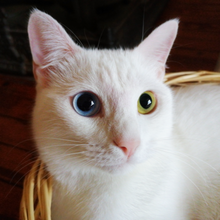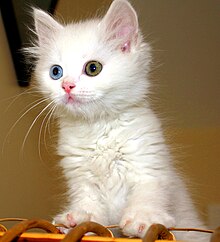This is an old revision of this page, as edited by Terazilastikcimlastik (talk | contribs) at 09:12, 23 August 2021 (Political things are removed.). The present address (URL) is a permanent link to this revision, which may differ significantly from the current revision.
Revision as of 09:12, 23 August 2021 by Terazilastikcimlastik (talk | contribs) (Political things are removed.)(diff) ← Previous revision | Latest revision (diff) | Newer revision → (diff) Not to be confused with Turkish Van or Turkish Angora. "Van kedisi" redirects here. For the standardized breed sometimes called Turkish Vankedisi, see Turkish Van. "Swimming cat" redirects here. For the species named the fishing cat (Prionailurus viverrinus), see Fishing cat. For the mustelid sometimes miscalled the "fisher cat", see Fisher (animal). Variety of cat| Van cat | |
|---|---|
 An adult odd-eyed Van cat An adult odd-eyed Van cat | |
| Origin | Lake Van area of the Armenian Highlands (Turkey) |
| Variety status | Not recognised as a standardised breed by any major breed registry. |
| Notes | |
| Van cats are a landrace, not a standardized breed. | |
| Domestic cat (Felis catus) | |
The Van cat (Template:Lang-tr; Template:Lang-hyw or Eastern Template:Lang-hy; Template:Lang-ku) is a distinctive landrace of the domestic cat found in the Lake Van in Turkey.
Van cats are relatively large, have a chalky white coat, sometimes with ruddy coloration on the head and hindquarters, and have blue or amber eyes or have heterochromia (having one eye of each colour). The variety has been referred to as "the swimming cat", and has been observed to swim in Lake Van.
The naturally occurring Van cat type is popularly believed to be the basis of the Turkish Van breed, as standardised and recognised by many cat fancier organizations; it has been internationally selectively bred to consistently produce the ruddy head-and-tail colouring pattern on the white coat. However, one of the breed founders' own writings indicate that the four original cats used to found the formal breed came from other parts of Turkey than the Lake Van area. The capitalised and run-together term "Turkish Vankedisi" is confusingly used by some organisations as a name for all-white specimens of the formal Turkish Van breed.
History
Van cats have been reported living in the vicinity of the city of Van and the general Lake Van area for centuries; how long is uncertain. Genetic research has shown that the domestic cat's ancestor, the African wild cat (Felis lybica lybica), was domesticated, for rodent control, about 9,000 years ago in the Near East when tribes transitioned from hunter-gathering to crop farming and settled life. In addition, the white-spotting in domestic cats appeared at the earliest stage of cat domestication, and is one of the points of evidence of early artificial selection. However, this does not necessarily mean that white cats have been in the Van area the entire time.
The landrace is named Van kedisi (plural kedileri) in Turkish, Vana gadu or Vana katu (Վանա կատու) in Western and Eastern Armenian, respectively, and pisîka Wanê in Kurdish.
Characteristics

Van cats are all-white, or sometimes mostly white with amber markings around the tail and ears. Locals to the Van area identify only the all-white type as Van cats, according to a 1991 BBC documentary, Cats, written and presented by Roger Tabor.
Their most notable genetic characteristic is their almond-shaped eyes that often are mismatched colours. The most valued and valuable members of the type generally have one amber-green eye and one blue eye.
Behaviour
Van cats are known for swimming in Lake Van. This may be the source of the popular, but possibly false or exaggerated, belief that the formal Turkish Van breed is innately more fond of water than the average cat. Lushington wrote: "Apart from their great capacity for affection and alert intelligence, their outstanding characteristic is their liking for water, not normally regarded as a feline attribute. They not only dabble in water and play with it, but have been known to enter ponds and even horse-troughs for a swim – they soon became famous as the 'swimming cats.'" It is unclear if Lushington means the cats of the Lake Van area, or her own Turkish Van standardised breed. Tabor's BBC documentary states: "The reason for fame is that the Van cat is known as 'the swimming cat'.... ere at Lake Van ... these cats do enter it, and swim."
Current status

Van cats form a landrace (naturally occurring, free-breeding variety, often feral), not a standardized breed of cat. They can still be found in east Turkey, near Lake Van, although their numbers have diminished (a 1992 survey found only 92 pure Van cats in their native area).There is a breeding programme for the all-white variety, operated by the Van Cat Research Centre (a.k.a. the Van Cat House), established in 1993 at the campus of Yüzüncü Yıl University. As of 2018, the center housed about 350 young adults and kittens, and is open to the public for a nominal entrance fee.
In regional culture
Van cats are claimed as a cultural icon by Armenians, Kurds, and Turks, who have inhabited the region at different periods in history.
Ottoman and modern Turkish
Cat breeder Laura Lushington (co-founder of the "Turkish Van" formal breed, from cats procured from various parts of Turkey), wrote of the local Van cats, "they are much loved and prized by the Turks for their exceptional character and unique colouring."
Turkish folklore has it that a Van cat was aboard Noah's Ark, and that as the flood waters receded, Allah (God) blessed the cat with a ruddy patch of fur on its head when it left the ark, after which it made its way to the city of Van via Mount Ararat. Many Van cats are all-white, however.
At the end of the 19th century, Sultan Abdul Hamid II is said to have owned a Van cat, and having one is still seen as a status symbol: a Prime Minister of Turkey received one as a gift, and an ambassador from Greece put himself on a waiting list to get one. Kittens from the breeding programme could be purchased for the equivalent of US$282 in 2011, and currently the Turkish Ministry of Food, Agriculture and Livestock does not regulate the export of these or any other cats from Turkey. The 1991 BBC documentary indicated that the all-white cats are locally prized in Van, and even coveted by visitors. While most Van cats are feral street cats, tourists have been known to steal pet Van cats from residents, including a shopkeeper interviewed for the show.
During the late 1990s, Van cats emerged as an informal municipal symbol of the city of Van – an enormous statue of a Van cat and her kitten now stands at the entrance to the city. The cat appears in a locally published comic strip, and in the logos of bus companies, shopping centres, and various other Van businesses.
The mascot of the 2010 FIBA World Championship of basketball, hosted by Turkey, was an anthropomorphised Van cat named Bascat. He had a white coat and odd eyes, one blue and one green, and his head was shaped with design cues from the crescent moon on the Turkish flag.
References
- ^ "Turkish Van Cats". Retrieved 8 April 2014. This tertiary source reuses information from other sources but does not name them. Like many sources, this one conflates the Turkish Van formal breed, which is actually British, with the local Van cat landrace of Turkey, and so must be interpreted with caution.
- ^ "Van Kedisi". "VanKedisi.net: En Güzel Kedilerin Sitesi (in Turkish). Archived from the original on 13 February 2013. Retrieved 12 February 2013. Machine translation into English.
- Archived July 18, 2006, at the Wayback Machine
- ^ Pond, Grace, ed. (1972). The Complete Cat Encyclopedia. London: Walter Parrish Intl. p. 114. ISBN 0-517-50140-6. This tertiary source reuses information from other sources but does not name them.
- ^ Tabor, Roger (writer/presenter); Crowther, Stephanie (researcher) (1991). "The Aristocats". Cats. Episode 5. Event occurs at 03:50–13:20. BBC 2. The documentary distinguishes the largely feral, white Van cats (the type identified as such by Van locals) from the auburn-marked Turkish Van breed, agreeing with other sources that the latter was developed by the British in 1955 from Turkish stock. This information is also presented in Tabor's tie-in book, Cats: The Rise of the Cat, ISBN 978-0563360117 (1995)
- Lushington, Laura (1963). "The Swimming Cats". Animals. 1 (17): 24–27.
- "Recognized and Admitted Breeds in the WCF". WCF-Online.de. Essen, Germany: World Cat Federation. 2012. Archived from the original on 13 February 2013. Retrieved 13 February 2013.
- Sample, Ian (19 June 2017). "Africats to the Purr-ymids: DNA study reveals long tale of cat domestication". theguardian.com. Retrieved 19 June 2017.
- Ottoni, Claudio; Van Neer, Wim; De Cupere, Bea; Daligault, Julien; Guimaraes, Silvia; Peters, Joris; Spassov, Nikolai; Prendergast, Mary E.; Boivin, Nicole; Morales-Muñiz, Arturo; Bălăşescu, Adrian; Becker, Cornelia; Benecke, Norbert; Boroneant, Adina; Buitenhuis, Hijlke; Chahoud, Jwana; Crowther, Alison; Llorente, Laura; Manaseryan, Nina; Monchot, Hervé; Onar, Vedat; Osypińska, Marta; Putelat, Olivier; Quintana Morales, Eréndira M.; Studer, Jacqueline; Wierer, Ursula; Decorte, Ronny; Grange, Thierry; Geigl, Eva-Maria (2017). "The palaeogenetics of cat dispersal in the ancient world". Nature Ecology & Evolution. 1 (7): 0139. doi:10.1038/s41559-017-0139. ISSN 2397-334X.
- Rob Stein, Washington Post (23 March 2008). "Using DNA to track the origins of cats". Sfgate.com. Retrieved 30 November 2011.
- Lipinski, Monika J.; Froenicke, Lutz; Baysac, Kathleen C.; Billings, Nicholas C.; Leutenegger, Christian M.; Levy, Alon M.; Longeri, Maria; Niini, Tirri; Ozpinar, Haydar (2008). "The ascent of cat breeds: Genetic evaluations of breeds and worldwide random-bred populations". Genomics. 91 (1): 12–21. doi:10.1016/j.ygeno.2007.10.009. PMC 2267438. PMID 18060738.
- Vinogradov, AE (1994). "Locally Associated Alleles of Cat Coat Genes". The Journal of Heredity. 85 (2): 86–91. doi:10.1093/oxfordjournals.jhered.a111428. PMID 8182285.
- Paruyr Sevak, "The Unsilenceable Belfry" (Պարույր Սևակ, ԱՆԼՌԵԼԻ ԶԱՆԳԱԿԱՏՈՒՆ), published in 1959: "...Թե՞ ազատվելու հուսահատ ճիգով Լող էին տալիս հազա՜ր ու հազա՜ր Վանա կատուներ՝Վառվող աչքերով ..."
- "Armenian Vans – Real "Aristocrats"". Tour Armenia. TACentral.com. Retrieved 17 July 2009.
- Hart, Robert (2010). Hart's Original Petpourri, Vol. 1. Langdon Street Pr. p. 4. ISBN 9781934938621. Hart cites a Cat Fancy magazine article as his source.
- Wright, Michael; Walters, Sally (1980). The Book of the Cat (1st ed.). London: Pan. pp. 50–52. ISBN 0-330-26153-3.
- "The Turkish Van The Swimming Cat". Cats and Kittens Magazine. Pet Pubg. 2000. Archived from the original on 4 December 2007. Retrieved 15 July 2009.
- Van City Guide. Ankara. 2005.
{{cite book}}: CS1 maint: location missing publisher (link) - //www.turkishangoracat.org/arastirma.aspx?arastirmaId=2
- "Van City Guide", Ankara, 2005.
- "Turkish Van Breed Profile". Archived from the original on 5 March 2016. Retrieved 14 January 2018.
- "Verimli yılın kedisi 500 TL". Hurriyet.com.tr. Retrieved 15 December 2017.
- "Yönetmelik: Yerli Evcil Hayvan Genetik Kaynaklarinin Kullanilmasi Ve, Yurt Dişina Çikarilmasi Hakkinda Yönetmelik ['Regulation: The Use of Genetic Resources and Domestic Pets, Regulation on the Removal of Abroad']". Resmî Gazete (in Turkish). Ankara, Turkey: Ministry of Food, Agriculture and Livestock. 21 September 2012. Issue 28418. Archived from the original on 13 February 2013. Retrieved 12 February 2013. Machine translation into English.
- "2010 FIBA World Championship Event Guide: Mascot". FIBA. Archived from the original on 14 September 2010. Retrieved 12 September 2010.
Other sources
"Van Cat". Kultur.gov.tr. Republic of Turkey Ministry of Culture and Tourism. p. 2005. Archived from the original on 29 September 2007. Retrieved 15 July 2009.
External links
- "Van Cat" page at the Republic of Turkey Ministry of Culture and Tourism website.
- VanCat.org, an independent website about Van cats
- Study about the Van Kedisi Van Kedisi, The Angora Cat Association, Turkey.
- Everything you wanted to know about Van Kedisi
| Van, Turkey | |
|---|---|
| History |
|
| Landmarks | |
| Transport | |
| Education | |
| Culture | |
| This list is incomplete. | |